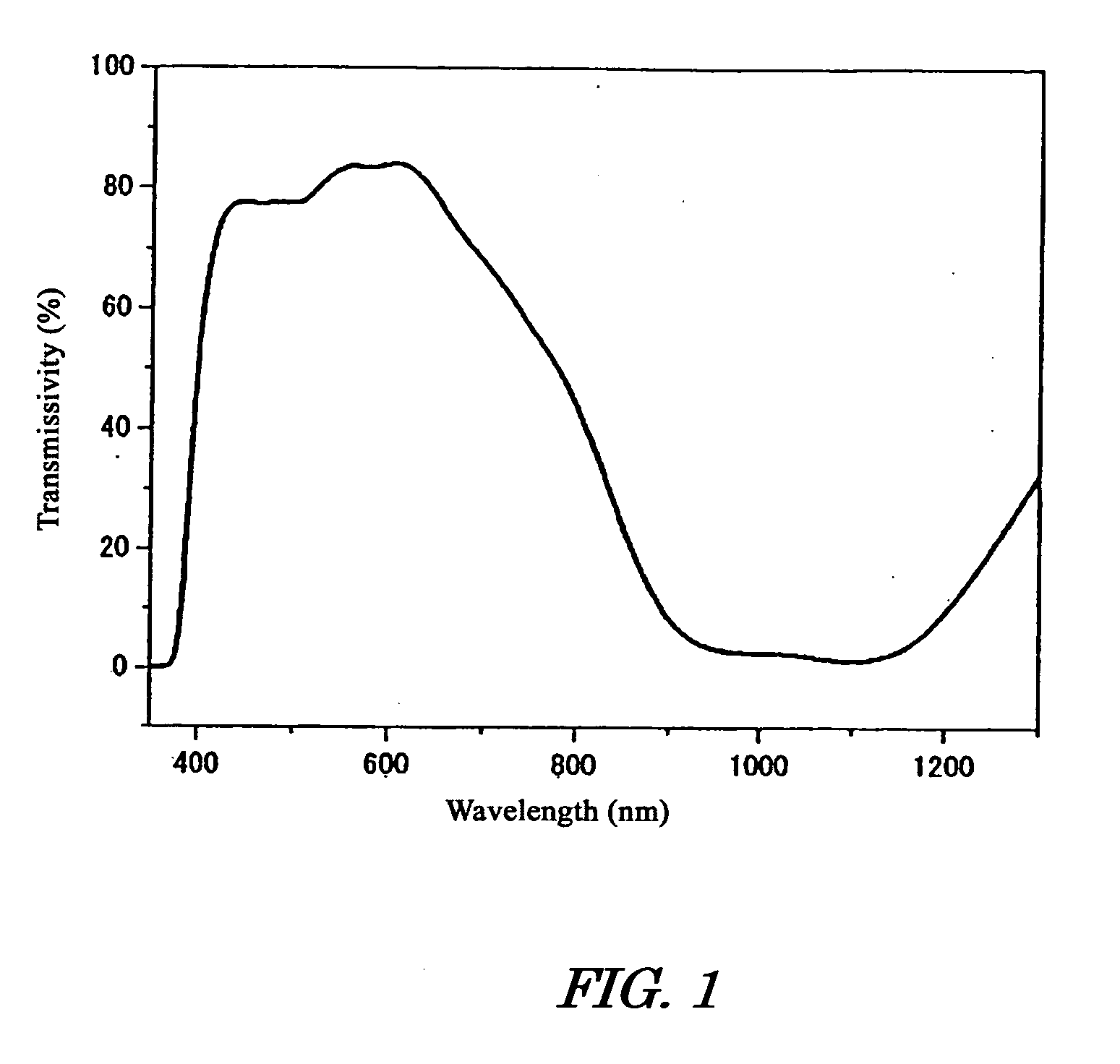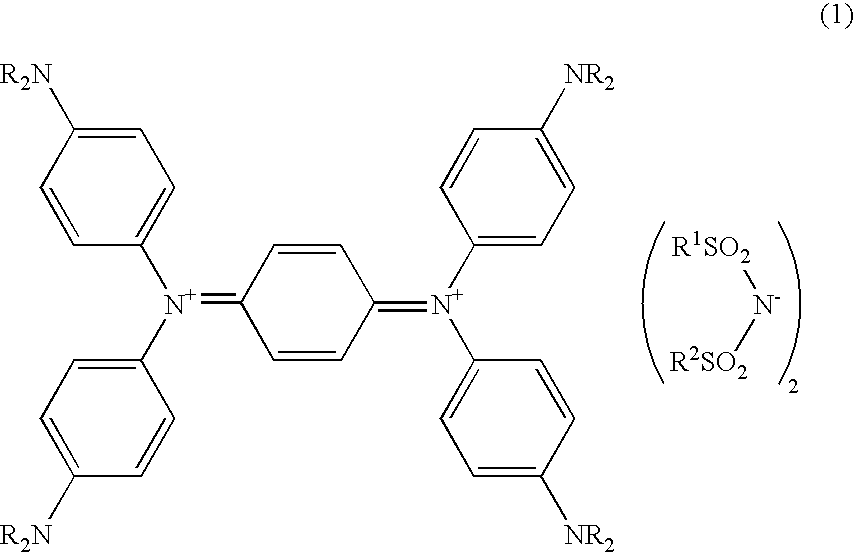Coloring matter absorbing near-infrared light and filter for cutting off near-infrared ray
a near-infrared light and dye technology, applied in the direction of photosensitive materials, instruments, auxillary/base layers of photosensitive materials, etc., can solve the problems of dye possesses some problems, heat and moisture resistance of this near-infrared light absorbing dye is still inadequate, and achieve excellent heat and moisture resistance
- Summary
- Abstract
- Description
- Claims
- Application Information
AI Technical Summary
Benefits of technology
Problems solved by technology
Method used
Image
Examples
example 1
[0050] (1) 10 parts of silver bis(trifluoromethanesulfone)imidate and 11.8 parts of N,N,N′,N′-tetrakis(p-dibutylaminophenyl)-p-phenylene diamine were added to 100 parts of DMF, the mixture was reacted at 60° C. for three hours, and the silver produced from the reaction was separated by filtration.
[0051] Next, 200 parts of water was added to the filtrate and the precipitate was separated by filtration and dried to obtain 15.7 parts of bis(trifluoromethanesulfone)imidate N,N,N′,N′-tetrakis(p-dibutylaminophenyl)-p-phenylene diimmonium as a near-infrared light absorbing dye. This near-infrared light absorbing dye had a maximum absorption wavelength (hereinafter abbreviated as “λmax”) of 1,074 nm and a molar absorption coefficient of 105,000 [L.mol−1.cm−1]. Differential thermal analysis confirmed that the near-infrared light absorbing dye had a melting point of 191° C. and a decomposition point of 310° C.
[0052] (2) Next, 2 parts of the near-infrared light absorbing dye was dissolved in...
example 2
[0056] Bis(trifluoromethanesulfone)imidate N,N,N′,N′-tetrakis(p-dibutylaminophenyl)-p-phenylenediimmonium was obtained in the same manner as in Example 1 except for using 12.6 parts of silver bis(pentafluoroethanesulfone)imidate instead of 10 parts of silver bis(trifluoromethanesulfone)imidate. This near-infrared light absorbing dye had a λmax of 1,074 nm and a molar absorption coefficient of 101,000 [L.mol−1.cm−1], a melting point of 185° C., and a decomposition point of 301° C.
[0057] A near-infrared light blocking filter was manufactured and the heat and moisture resistance of the filter was examined in the same manner as in Example 1. The results are shown in Tables 1 and 2.
example 3
[0063] 10 parts of N,N,N′,N′-tetrakis(p-aminophenyl)-p-phenylenediamine, 55 parts of iodated benzyl as a substituent raw material, and 30 parts of potassium carbonate were added to 100 parts of DMF solvent and the mixture was reacted at 120° C. for ten hours while stirring.
[0064] Next, 500 parts of water was added to the reaction solution and the precipitate was separated by filtration, washed with water, and dried at 100° C. to obtain 23.1 parts of N,N,N′,N′-tetrakis(p-dibenzylaminophenyl)-p-phenylenediamine.
[0065] 23.1 parts of the above reaction product and 32.5 parts of silver bis(trifluoromethanesulfone)imide as an anion raw material were added to 200 parts of DMF solvent, the solution was reacted at 60° C. for three hours with stirring, and the produced silver was separated by filtration.
[0066] Next, 200 parts of water was added to the obtained filtrate and the precipitate was separated by filtration, washed with water, and dried at 100° C. to obtain 32.2 parts of the near-...
PUM
| Property | Measurement | Unit |
|---|---|---|
| wavelength | aaaaa | aaaaa |
| wavelength | aaaaa | aaaaa |
| decomposition point | aaaaa | aaaaa |
Abstract
Description
Claims
Application Information
 Login to View More
Login to View More - R&D
- Intellectual Property
- Life Sciences
- Materials
- Tech Scout
- Unparalleled Data Quality
- Higher Quality Content
- 60% Fewer Hallucinations
Browse by: Latest US Patents, China's latest patents, Technical Efficacy Thesaurus, Application Domain, Technology Topic, Popular Technical Reports.
© 2025 PatSnap. All rights reserved.Legal|Privacy policy|Modern Slavery Act Transparency Statement|Sitemap|About US| Contact US: help@patsnap.com



